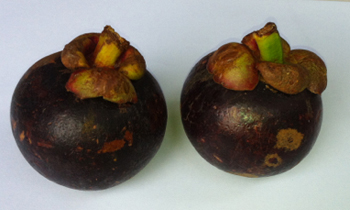Mangosteen And Cancer
The most important thing to understand is that there is no reliable cure for cancer. Despite decades of research, in 2003 the same percentage of people died from colon, breast, lung and prostate cancer as died in 1957.
However, despite this sad news, there is hope for cancer patients.
A prominent free-radical researcher Dr. Bruce Ames estimates that the DNA material in every one of the trillions of cells in our body receives about ten thousand hits from free radicals every day!
To prevent a breach of the body’s defences in the face of an attack of such magnitude requires the concerted efforts of all the agents of the immune system, which can be seen as the armed forces of the body, along with the collaboration of the policemen or the gene regulatory mechanism.
When, despite the body’s best efforts, a breach of our defences occurs, a tumour forms.
Like a city captured by enemy forces, the tumour becomes a stronghold that has multiple defence systems with which it resists the continued attacks of the immune system.
Within the stronghold, tumour viruses and deranged cells proliferate and are sent out like secret agents to corrupt (infect) healthy cells elsewhere.
The cells of the tumour itself grow without the restrictions that govern normal cells and, almost immediately, become the fastest growing tissue in the body. As they grow rapidly, they steal nutrients ad energy needed by healthy cells.
For this reason, cancer patients may appear starved and wasted (a medical term called cachexia).
Tumours cause pain by becoming large enough to press on nerves or other pain sensitive structures.
They can block ducts or intestines causing severe bodily dysfunction.
They often completely take over whole organs, ie the liver or lungs, crowding out functioning cells and leading to organ death.
Many cancers spread or metastasise to other areas of the body invading organs far from where they originally started. In contrast, most normal cells are anchored in place.
Because of this mobility, a breast cancer cell can make its way to the brain, for example, and start another tumour. When metastases (distant sites of cancer invasion) are present, the enemy has already developed several strongholds throughout the body.
If the cancer is unchecked, death is the inevitable outcome.
Standard cancer intervention consists of the surgical excision of tumours and/or their destruction by radiation or chemotherapy. Immuno-stimulative therapies, although rare, also exist.
Unfortunately, most of these interventions also damage normal healthy tissue as well.
For example, chemotherapy indiscriminately destroys all rapidly growing cells destroying normal hair follicles, blood-producing bone marrow cells, the cells which line the intestine and, most importantly, the protective cells of the immune system which are essential to the prevention of infection.
The challenge is to destroy the cancer before the chemotherapy or other treatment mortally weakens the patient.
It is ironic to consider that the radiation and the free radical attacks of chemotherapy that are used to destroy the tumours may resemble the processes that caused the cancer in the first place!
Mangosteen And Cancer
Mangosteen’s xanthones (phytoceuticals found only in this plant) have proven ability to destroy cancerous cells in laboratory studies.
For example, garcinone E, a xanthones, was more effective than five commonly used chemotherapy agents (vincristine, mitoxantrone, 5-flourouracil, cisplastin and methotrexate) for stomach, lung and liver cancer in a recent well-designed in vitro study.
In order to understand the several means by which mangosteen phytoceuticals protect us from cancer, I must return for a moment to the most accepted theory of cancer development.
Step 1
The genetic material (DNA) of the cell is damaged by free radicals from pollution, metabolic residues and infection or disease and mutation occurs.
Step 2
The damaged cell divides and begins to disobey the rules of normal cell replication. Cancer now exists.
Step 3
Tumour-promoting agents such as PGE 2 then stimulate the growth of the tumour often leading to metastases.
Where do the mangosteen phytoceuticals intervene in this deadly process?
Well, the answer is that in addition to being anti-tumour agents when cancer already exists, they prevent and arrest cancerous change at every step.
It is quite impossible for us to avoid exposure to carcinogens and the free radical assaults that follow, but the anti-oxidants and other active phytoceuticals in mangosteen can provide protection from critical cell damage.
They do this by regulating gene expression, repairing free radical damage and blocking the production of tumour-promoting agents.
As a COX 2 inhibitor, for example, mangosteen blocks the production of PGE 2 (prostaglandin E2) thereby impeding the promotion and the progression of cancer when DNA damage does occur.
Finally, they directly attack tumour cells.
A word of caution
I’ve described previously in Mangosteen, the X-factor, the differences between medicines and phytoceuticals.
Medicines are like sledgehammers compared to the rubber mallets of the phytoceuticals.
Do not stop any cancer treatment to replace it with mangosteen.
The phytoceuticals will do their work even in the presence of other cancer therapies.
Finally, while it is exciting to realise what the mangosteen phytoceuticals will do in the area of cancer treatment, it is far more important to prevent the development of cancer in the first place.
Waiting until you develop cancer you may not feel the protective work the mangosteen is doing in your body, but as the years go by the results you’ll experience will be difficult to imagine.
Unfortunately, many of your friends who chose not to supplement will not be around to celebrate your good health.
By J. Frederic Templeman, M.D.
Published originally in Here & Now magazine as part of a series on the healing properties of mangosteen.
See Dr. Templeman’s website on mangosteen: www.mangosteenmd.com
Leave your comment about Mangosteen And Cancer or share with your friends on Facebook

Leave a Reply